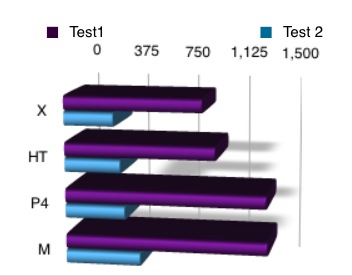Intel Insight
When you go to Taco Bell – how do you decide what to buy ? They all cost roughly the same – so what do you do ?
I work in lab – Unmanned Vehicles and Surveillance. My job involves running huge computer simulations for long times (20hours sometime). So I thought I’ll do something.
I run about 7 computers in my lab. Basically there are 4 configurations – and I decided to see which one is the best. There are many websites and magazines that test processors – but no test is perfect. They are all skewed or only partially right. I though I should do my own test – may be its not perfect either – but its something I can do with my hand observe the results. Here’s what I did
The competitors
Xeon 3.2 Ghz or the ‘X’

P4 2.4 Ghz – call it ‘P4’

P4 HT 3.2 Ghz or ‘HT’

M 1.86 Ghz or the ‘M’

All the 4 computers run Windows XP. They all have atleast 1 GB RAM (the Xeon has 4GB). They are uswed just to run the code – no one is simultaneously using it for anything else. Minimum applications are running – not even an antivirus.
The code CMARC
The code I ran on them is known as CMARC. It is a FORTRAN code written by NASA for aerodynamics work. This code has NOT been optimized for any specific processor – which mean it’s a regular application. It just performs continuous mathematical calculations (in this case a 500 by 500 panel method matrix) and does not consume much memory. It only maximizes the processor – 100%. So basically, it depends fully (close to fully) on the processor – so I am going to use this as the test to judge the processors.
Results

After running test I . I got these results
X – 916 minutes
P4 - 1333 minutes
HT- 1001 minutes
M – 1343 minutes
Next was test II – different number for cycles than last time. Here are some results
X – 330 minutes
P4 – 400 minutes
HT – 373 minutes
M – 500 minutes
Conclusions
X
I am not surprised to see that the Xion is the fastest it costs a lot of money. What is most noticeable for me, is that the Performance remained pretty much the same way for the complete duration in the Xeon. The system didn’t slow down in the middle. (The code shows number of cycles completed– so I used a stop watch and verify the duration per 1000 cycles now and then.)
HT
I didn’t expect P4 HT to be any better than the P4, but surprisingly - it is. I have 2 P4s and 2 HTs actually, all of them showed very close results. Well its not much better – just a bit - infact may be its just the higher clock speed and nothing to do with the threading :). Just a couple of days ago, I was talking to my buddy GB and we were discussing how XP does not really utilize the multi thread capability. I am a bit surprised by these results.
P4
The P4 was slow – true – but pretty surprising for 1 thing. It had stable performance too. It didn’t slow down in the middle. Looking closely – you can see that the P4 and M behave some what similarly – their performance overlaps. Why ?
M
I am truly astonished (not in a good way) with the M. I know it’s a small processor with a big bus. Its roughly the same speed as the P4 – but do you know why ? Well, the M slows down ! Towards the end, the system is much slower that it was during the beginning ! Well the keep varying a bit here and there – but finally its about 20% slower than it was when it began (verified by hand/stop watch) , I have no idea why – may be one of you guys can explain in COMMENTS section.
The Xeon stands out definitely – but that’s why it on my server with a huge price tag and 8 cpu fans. I mean there is a reason why they don’t have Xeon laptops !
So among the other 3, honestly – its not MUCH different. Especially, M – its not better than the rest. And I still believe XP ( and all XP applications ) don’t utilize the threading capability – its just higher clock speed (2.3Ghz P4 and 3.2Ghz HT) in the above case that made the difference. There is about a 400$ difference between each of these processor based computers – for what?
So to answer my first question – you go to Taco Bell what do you buy ? Well – they all have beans, they are all rolled in flour tortilla, they all cost the same roughly. Well - it doesn’t matter what you buy – they are all pretty much the same.

P.S : This is what I use :) . Too bad they don't make it any more.

8 Comments:
Pretty qool u took some time to actually put those stats as a graph. U probably have to analyze a lot more aspects before drawing solid conclusions but u still brought out a few good points. Nice work.
mmm...pentium M is spossed to be based on P-iii and lookie here:
http://www4.tomshardware.com/2005/05/25/dothan_over_netburst/
P3 is spossed to be a better proc except that it couldn't be used at higher clock speeds...
- GB
Yes PIII is very good. Infact, in one of our other labs- we have a P3 cluster (30 P3 processors) running. Well I guess M has better heating/cooling trend which is good for a laptop. I just dont like Intel's idea of producing a new processor that is slower than existing one.
dude u a Macaddict!, in tht case u shud cm to west coast. I am not even remotely familiar with the topic though, so definitely a knowledge-gaining article for me!!
From my experience processing power is only one aspect of engineering computing. Faster == Good but Memory can and often is the killer. Designing software with a lot of parallelism to exploit hardware and reduce memory fetches will be among the biggest design challenge. That AMD has an integrated memory controller within the chips die means its gonna be faster for 64 bit memory intensive apps. Cool benchmarking though. I personally think hyper threading is "hype" and a marketing tactic. Its nice to note Pentium M (Centrino) is killer. I think it also supports hyper threading.
- Deepak
Your are Excellent. And so is your site! Keep up the good work. Bookmarked.
»
I really enjoyed looking at your site, I found it very helpful indeed, keep up the good work.
»
Hmm I love the idea behind this website, very unique.
»
Post a Comment
<< Home